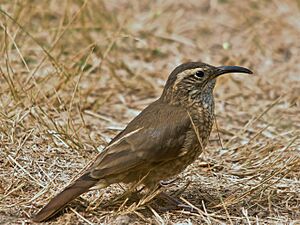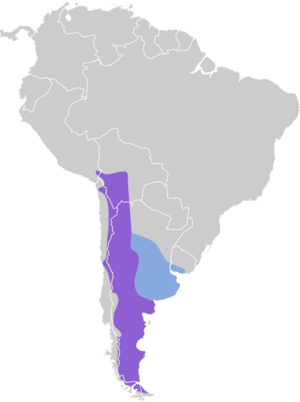Scale-throated earthcreeper facts for kids
Quick facts for kids Scale-throated earthcreeper |
|
|---|---|
 |
|
| Conservation status | |
| Scientific classification | |
| Genus: |
Upucerthia
|
| Species: |
dumetaria
|
 |
|
The scale-throated earthcreeper (Upucerthia dumetaria) is a type of bird. It belongs to the ovenbird family called Furnariidae. You can find this bird in Argentina, Bolivia, Chile, Peru, and maybe even Uruguay.
Contents
Meet the Scale-Throated Earthcreeper
This bird is known for its unique throat and how it searches for food on the ground. It's a fascinating creature that lives in different parts of South America.
Different Types of Earthcreepers
The scale-throated earthcreeper has three main types, called subspecies. They are U. d. dumetaria, U. d. peruana, and U. d. hypoleuca. For a while, another bird, the Patagonian forest earthcreeper, was thought to be a fourth type. But scientists decided it was a separate species around 2009.
What Does It Look Like?
The scale-throated earthcreeper is about 20 to 22 centimeters (8 to 9 inches) long. It weighs between 37 and 55.5 grams (1.3 to 2 ounces). It's a fairly large bird with a long, curved beak. Both male and female birds look alike.
Adult birds of the main type have a whitish stripe above their eye. Their face is grayish-white and dark grayish-brown. The top of their head is a dull dark grayish-brown. Their back and rump are a plain brownish-gray. Their tail feathers are dark brown with reddish-brown tips. The outer feathers have more reddish-brown color.
Their wings are grayish-brown with lighter edges. The base of their flight feathers is a dull reddish-brown. Their chin is whitish, and their throat is whitish with thin dark lines. Their chest is dark grayish-brown with a pattern that looks like black scales. Their belly is whitish, and their sides are grayish-brown.
Their eyes are dark brown, and their beak is blackish. Their legs and feet are dark brown. Young birds have faint stripes on their forehead and back. They also have more of the scale-like pattern on their underside than adults.
The U. d. hypoleuca type looks similar but has more reddish-brown on its upper parts. Its underside is more buffy (a pale yellowish-brown). The U. d. peruana type is like hypoleuca but has a longer beak. It is also a bit lighter in color and has less reddish-brown in its wings.
Where Does It Live?
The main type of scale-throated earthcreeper lives in southern Chile. It also lives throughout Argentina at different times of the year. The U. d. hypoleuca type is found in western Bolivia, central Chile, and western Argentina. The U. d. peruana type has only been seen in southeastern Peru.
This bird lives in puna grassland (high-altitude grasslands) and dry, bushy areas. It likes rocky grasslands, bushy slopes, and areas with shrubs and rocks. It can live at very high elevations, up to 4,000 meters (about 13,000 feet) in the Andes mountains.
Behavior and Habits
Movement and Migration
Most scale-throated earthcreepers stay in the same area all year. However, some birds from southern Chile and Argentina move north. They might travel as far as northern Argentina and possibly southern Uruguay. Scientists are still studying their exact travel routes.
What Do They Eat?
The scale-throated earthcreeper eats arthropods, which are creatures like insects and spiders. It usually hunts alone. It finds its food by poking its beak into the ground and picking up small creatures.
Reproduction and Nests
These birds usually breed during the summer in the southern hemisphere, from October to December. They are thought to stay with one partner. They often build their nests at the end of a tunnel. They dig these tunnels in earth banks or sloping ground. They line the nest chamber with grasses. Sometimes, they also nest in holes in human buildings or in cracks in rocks. A female bird usually lays two to four eggs. Scientists don't yet know how long the eggs take to hatch or how long the young birds stay in the nest.
What Do They Sound Like?
The scale-throated earthcreeper often sings from the top of a bush. Its song sounds like "chippy, chippy, chippy, chip" or "pli-pli-pli-pli-pli...". The song gets a little higher in pitch and sometimes goes lower at the end. Its calls include a "wheezy 'keet'" or a "squeaky-sounding 'keep'". It also makes a sharp, dry sound like "dzit".
Conservation Status
The IUCN (International Union for Conservation of Nature) says the scale-throated earthcreeper is a species of "Least Concern." This means it's not currently in danger of disappearing. It lives across a large area. However, its total population size is unknown and seems to be getting smaller. No major threats have been found right now. It is quite common in the southern parts of its range but very rare in the northern parts. Its home is generally safe from human activities. The only possible threat is too much grazing by animals in its habitat.


